#greecian
Text

Ludwig von Hofer (German, 1801-1887)
Psyche, 1835
#Ludwig von Hofer#copy of the original#german art#german#germany#psyche#greek mythology#mediterranean#roman#greecian#southern europe#art#fine art#european art#europe#classical art#european#fine arts#europa#classic art#sculpture
1K notes
·
View notes
Photo

#azaleasdolls#greecian#mediterraneo#meditteranean#mediterranean#europe#european#brunette#princess#azaleasdoll#spring#persephone#persephades#dove
1 note
·
View note
Photo




Also!! Princesses! They’re always so much fun to draw <3 Cadence is probably my favorite of the batch here. Also bonus Future!Twilight because i love her
reblogs are appreciated. do not repost
#my little pony friendship is magic#mlp fim#twilight sparkle#princess celestia#princess luna#princess cadance#mlp twilight sparkle#mlp celestia#mlp luna#mlp cadance#future twilight's design in canon is just...not good#she doesn't look right with celestia's body type AT ALL so i used Luna as a reference#and also gave her some yellow in her mane from her rainbow power design#and for cadance i played with the greecian aesthetic the crystal empire has#luna has some nightmare moon influences in her desig#*design#the splotches and the more batlike wings#and with celestia i gave her more warm and sunny colors because... Sun....princess... yeah#space draws
312 notes
·
View notes
Text
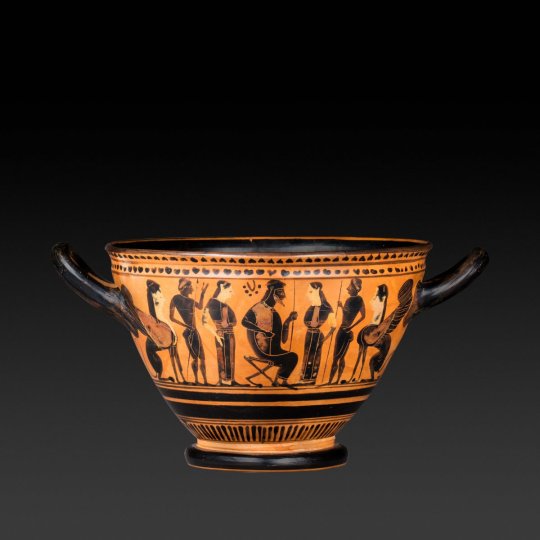
The skyphos is a large ceramic cup used by the ancient Greeks for the consumption of large quantities of wine. At informal male gatherings known as symposia, heady philosophical discussions usually progressed to drunken riotousness as the contents of the skyphoi were replenished.
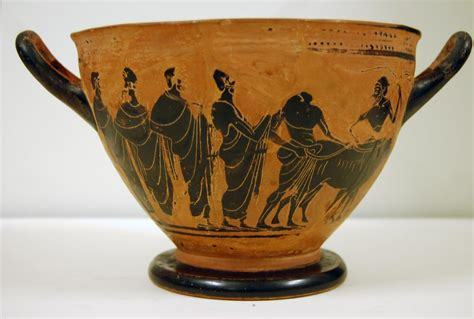
Skyphoi were often decorated with exquisitely painted scenes with clear references to Dionysos, the god of wine and revelry. In cases like the one seen here, however, the decoration evokes a far different relationship with the divine.
The scene on this skyphos represents a parodied depiction of the Judgment of Paris, a well-known incident from The Iliad, Homer’s epic story of the invasion of Troy by the Greeks. The evocation of a world of mysterious, irrational forces on the vase reveals a side of the Greek temperament at odds with the magisterial order imposed on human society by the Olympian gods.
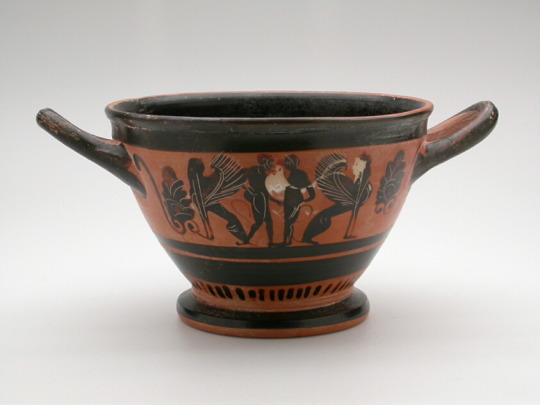
The image of black people plays a key role in the reconciliation between the everyday world of the Greeks and the more intimate experience of spiritual revelation.
The Trojan prince Paris was appointed by Zeus, ruler of the Olympian deities, to step in and settle rival claims of consummate beauty made by the goddesses Hera, Minerva and Aphrodite.
The fateful event is here reduced to only three summarily rendered characters. At left and center, respectively, Hera and Aphrodite are seated on the rocky slopes of Mount Ida, a sacred spot in the northwestern part of modern Turkey. Hera, queen of the gods, prominently wields her scepter, while Aphrodite, goddess of beauty and sensuality, holds the just-presented wreath of victory.
Before them stands Hermes, the winged god of communication and safe passage. In return for favoring Aphrodite, Paris received Helen of Sparta, the loveliest of all mortal women. The struggle by the Greeks to recover the already married Helen lasted 10 years and ended with the total destruction of Troy.
The story of the Judgment of Paris has been told and retold countless times, both in literary versions and in artistic form. Here, however, the straightforward treatment of the event has taken on a radically different form.
The face of Hera leers grotesquely with staring eyes and gaping mouth. Similarly, the representation of Aphrodite departs in a quite unexpected way from the somatic norm of the Greek figure. Rendered in strict profile, her negroid features are clearly evident. The same evocation of blackness characterizes the head of Hermes confronting her own.
All painted wares of this particular type are associated exclusively with the Kabeirion, a sanctuary located several miles outside the Greek city of Thebes. The sacred precinct is named after the kabeiroi, underground deities worshipped in secret. The appeal of this and other ancient mysterious religions such as the Egyptian Isis cult lay in the profound shift from the conventional obeisance to the gods to a rapturous, personal identification with the divine by initiates to the cult.
The numerous drinking vessels found at the Kabeirion seem to have formed an integral part of the rituals held at the sanctuary. The rites apparently concluded with the smashing of the cups, perhaps as a way of invoking the power of the kabeiroi.
The painted scene on the skyphos could also recall a dramatic presentation of the event, perhaps a short play staged in honor of the local deities. In this case, actors such as those portraying Aphrodite and Hermes on the cup would presumably have appeared as Africans, their affect aided by carved and painted theatrical masks.
The same inclusion of blackness holds true for several other types of scenes found on the Kabeirion skyphoi. One of the most remarkable of these presents a dramatic confrontation taken from Homer’s Odyssey, the companion epic to The Iliad.
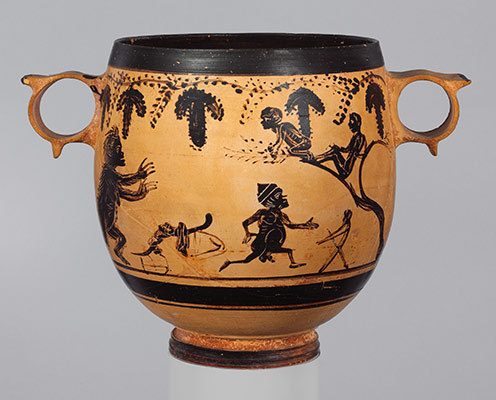
During a stop along the wandering path of his journey home, the great hero Odysseus encounters the sorceress Circe, who tries to transform him into a pig in order to keep him with her. She offers him the fateful potion, which he rejects with a surprised gesture. Circe appears unmistakably as a black woman, while Odysseus’ image is in keeping with the standard type of the old man in Greek art.
The underlying emphasis on powerful, occult forces in the Circe scene made it an ideal subject for use at the Kabeirion. The moment of potential metamorphosis from a rational creature into another, less comprehending form alludes to the ecstatic experience undergone by the initiates of the cult. Interestingly, the notion of a black Circe as skilled practitioner of spells reappears in our own time as the protagonist in Toni Morrison’s Song of Solomon.
The visual characterization of blacks as figures from Greek legend seems to have been derived from the association of Africans with the liminal zones of the earth, associated by the Greeks with barbarism—simply meaning non-Greek culture. On other skyphoi, the range of black figures includes the highly popular type of the cave-dwelling pygmy.
The great appeal of such foreign cultures for the Greeks stems, at least in part, from the belief that imagery derived from the African physiognomy could effectively counter the powerful, unsettling forces at large in the world.
As in any society, the farther a given form departed from Greek norms, the more unsettling it seemed. This response was hardly demeaning, however, since for the Greeks the exotic in nature held an enormous capacity for warding off evil. The apotropaic effect was greatly enhanced by the caricatural treatment of the subject, as seen in the representation of Aphrodite and Hermes on this skyphos.
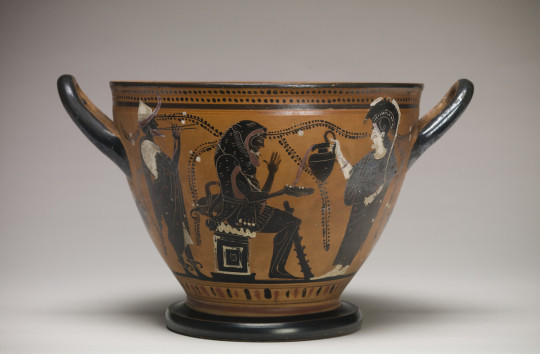
The apparently mocking treatment of the black figures in the Judgment of Paris should be regarded as a calculated inversion of the usual relationship between the Greeks and their gods. At a site where the powerful and potentially dangerous Kabeiric mysteries were summoned, the normal place of Greek religion was given over to the protection of the site’s resident forces.
The rendering of the Olympian gods as a positive form of the racialized other is supported in the extensive modern literature on the subject. Such a view is borne out by the argument of the pioneering scholar Frank Snowden that true racial prejudice did not exist in ancient times but evolved only with the advent of the slave trade in the early-modern period.
Snowden’s view is further supported by the incredible variety of sympathetic guises taken by the black form in ancient Greek and Roman art.
The profile features of a black man appear on coins minted by the city of Delphi in apparent homage to the venerated founder of the city. Among the Etruscans, the masklike black face placed on the eaves of a sacred shrine served as a powerful means to repel evil forces, a quality incidentally attributed to the kabeiroi themselves.
#Why Greek Goddesses Appear as Black Women on an Ancient Ceramic Cup#Black History#greecian lies#white lies
5 notes
·
View notes
Text

003 | The Avian (Aka Hawk)
#jart#the avian#003#theyre like a god in some way which is why i did like a greecian robe n shit#i really like this image ^_^
4 notes
·
View notes
Text




I am in love with this set. Like. I want to keep doing more fantasy fashion where I'm just me but....fantasy. Not a cosplay. Just me, but not.
Photos: Katya Nunez Photography
3 notes
·
View notes
Text
furries in classical art styles is so fun
9 notes
·
View notes
Text
"A sob caught in my throat-- somewhere in the distance, if only I could walk far enough to find it, there was safety. I was sure. I could see it more clearly than I saw the ocean before me. Soft hills, wooded with welcoming forests, a quiet farm house, a spiral of smoke drifting into the air from its chimney. A peaceful solitude, a place where no agony would shatter my skull. A place where nothing of note would ever happen so there would be nothing to foresee."
x. "Elektra", Jennifer Saint
#Elektra#Jennifer Saint#📚#this book was so melancholy-- which like. to be fair i guessed it would be lmao. given the like. source material lmao.#but specifically the story of elektra has always made me feel... weird lmao. i sympathize far more with clytemnestra--#esp given the incredible misfortune of having agamemnon as a husband LMAO.#the writing was phenomenal. the author did a really great job of working in the mirroring between clytemnestra&elektra#&the povs were all extremely distinct voices.#... cassandra was my fav character&also had all my fav parts of the story lmao which feels kind of like a cheat#given her EXTREMELY limited role in the stories of the kin of atreus lmao.#but i cannot help it-- cassandra is undeniably one of my fav greecian mythological figures. close 2nd to medea for fav princesses.#so if shes around in a story ill likely favour her. 🤷🏾♀️💘💘
3 notes
·
View notes
Note
Have sympathy for the guy all you want but don't call thus 19 year old man a child. Yeah it's a pity he was forced into it but he wasn't a kid. Don't add to the issue of adult men being infanfilised whenever something bad happens.
Especially when there were ACTUAL children on that refugee boat.
hey come off anon and be fucking stupid with your face attached to it. you deserve to be shamed all the way to hell you disgusting little reprobate. if you think 19 years was long enough on this planet that’s the dumbest thing i’ve ever heard in my whole life. you think adulthood is measured by the legal statute of years lived instead of experience in life, you are completely mistaken. a majority of 19 year olds aren’t in college. they can’t drink. they can’t rent a car. they still haven’t decided on personalities.
the double standard in the media coverages is a valid talking point NOT somehow choosing to make this about “infantilizing men” you moron. the greecian disaster was a horrible fucking tragedy, unfortunately i am one human person and not a news outlet or a conglomeration of people blasting out posts at the speed of light. i am one dude who was sad about a 19yo who died cus he loved his dad, while people were trivializing his death because it was funny the CEO of dumbshit corporation decided to ignore basic safety to attempt a 12500 ft dive.
you’re a mean spirited ugly person who can’t think their way out of a cardboard box and you’re even worse for doing it on anon, because you know i’d block you sight unseen.
#unfortunately this is the first i’ve heard about the greecian refugee boat 🤷🏻♀️#which broke my fucking heart into a million pieces#and it would’ve been fair to have approached me as ‘can you also talk about this?’ which i’ve done for people who’ve asked in the past#but this person approached me with such bad-faith off the bat instead of idk. talking to me like a person#furthermore the fact that i had to look up the greek refugee boat but i’ve been seeing coverage of the Titan since it went dark#is proof that there was biased coverage in the media. which isn’t my fault at all.#i’ve talked about this before that i spent a majority of my teen years obsessed with tragedy and i got tired of it so i have unplugged#myself from hearing about tragedies all the time#and i am a happier person now#but i still feel guilty when i don’t talk about things like this. but i don’t want to talk about sad stuff all the time anymore#i’m sorry but this blog is like my home and i have to limit the amount of sadness i talk about.#also. not to further rain on your parade but i just turned 20 and i feel very comfortable calling Suleman a child. because i’m still a#fumbling child. especially in all the ways that matter.
3 notes
·
View notes
Text
You know that saying about how if you give something a name, you have to keep it?
That applies to ships too.
#flashing back to a year ago when I was like hahaha this ship should be called Creecien because it rhymes with greecian#because it’s a TRAGEDY#while pretending I didn’t for real ship it
8 notes
·
View notes
Text
New Verse: Hades
Slain during the Trojan war, fighting under the Amazonian Queen Penthislea against the Greeks, Urbosa's time in Elysium has proven eventful. Initially, she was quite the firebrand, but has settled into a cozy spot, training shades she sees potential in. She was enlisted by Hades to stop his wayward son on his attempts to reach the surface in exchange for reuniting with her lost love, a deal that had been made during her life by Aphrodite and Zeus in exchange for fighting with the Trojans. She doesn't know how much stock she puts in her Master, but Prince Zagreus is a breath of fresh air compared to the other champions of Elysium. Still, she quietly holds out hope that one day she might be reunited with her wife - by Hades' or any other hand.
1 note
·
View note
Text

Sir Lawrence Alma-Tadema (Dutch-British, 1836 - 1912)
The Finding of Moses, 1904
#Sir Lawrence Alma-Tadema#Sir Lawrence Alma Tadema#1800s#the finding of moses#greecian#greek#nubian#egypt#egyptian#ancient history#ancient world#classic art#art#fine art#european art#classical art#europe#european#fine arts#oil painting#europa#mediterranean#the bible#pharaoh's daughter#arts#painting#artwork
81 notes
·
View notes
Text
Deboning- Mykonos
#greece#travel#fresh fish#mykonos#outdoor dining#food#cute greecian#al fresco#fine dining#dinner#foodie#grouper#gourmet
0 notes
Text
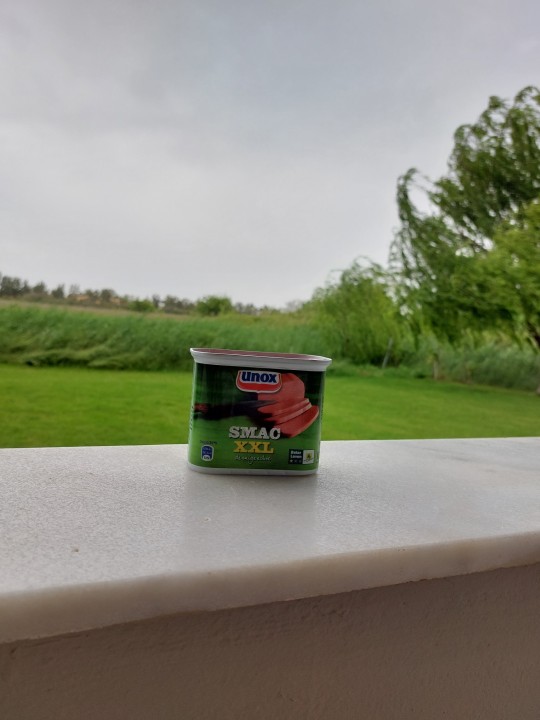
0 notes
Text
“Give yourself fully to your endeavors. Decide to construct your character through excellent actions and determine to pay the price of a worthy goal. The trials you encounter will introduce you to your strengths.”
— Epictetus
I love this quote so much because it is so heavily important to remember, enduring difficult things and times grant you the ability to survive further. I’ve done well. Gotta keep going.
#weoutchea#lvrsdrk#pieces#scorpio#Epictetus#ancient greek#greecian philosopher#for black men#black poets on tumblr#black men#written#black writers of tumblr
1 note
·
View note
Text
anonymous | Misc. Asks
Θώθ, what's this?


"An unfortunate upshot of Egypt being Hellenized and the lexicon of the present day Internet."
#They're Listening... : asks#(Another) Unknown Entity : anonymous#Scribe of the Gods : Thoth#[ Thoth complains about the Greecian alphabet part 9000 ]#[ fun fact: Θώθ is literally pronounced 'Thoth' ]#[ idk how many people know that's just 'Thoth' in Ancient Greek and not yet another name for him ]
0 notes